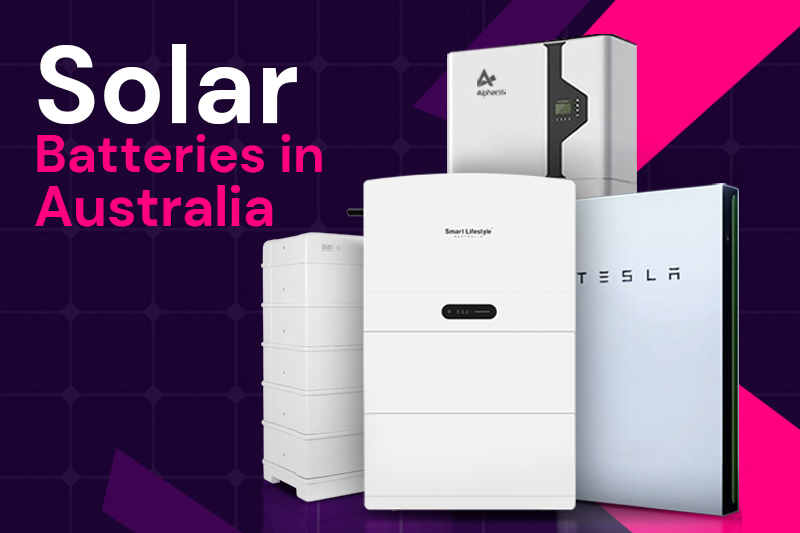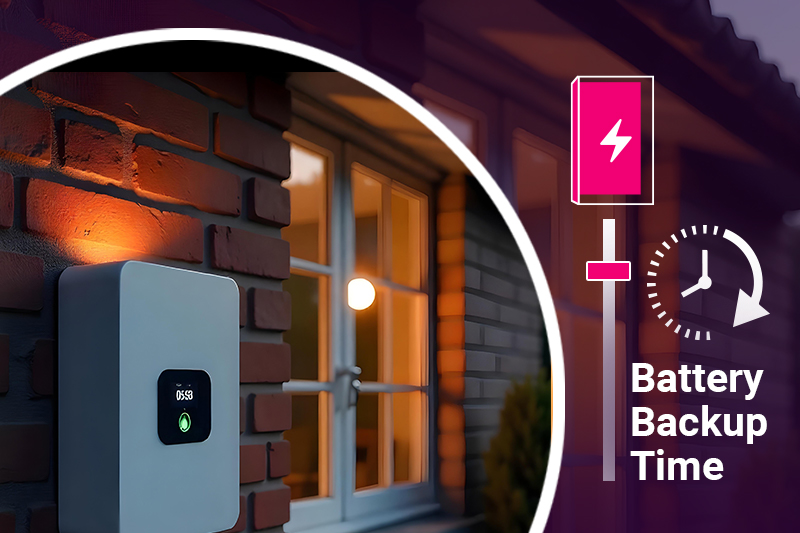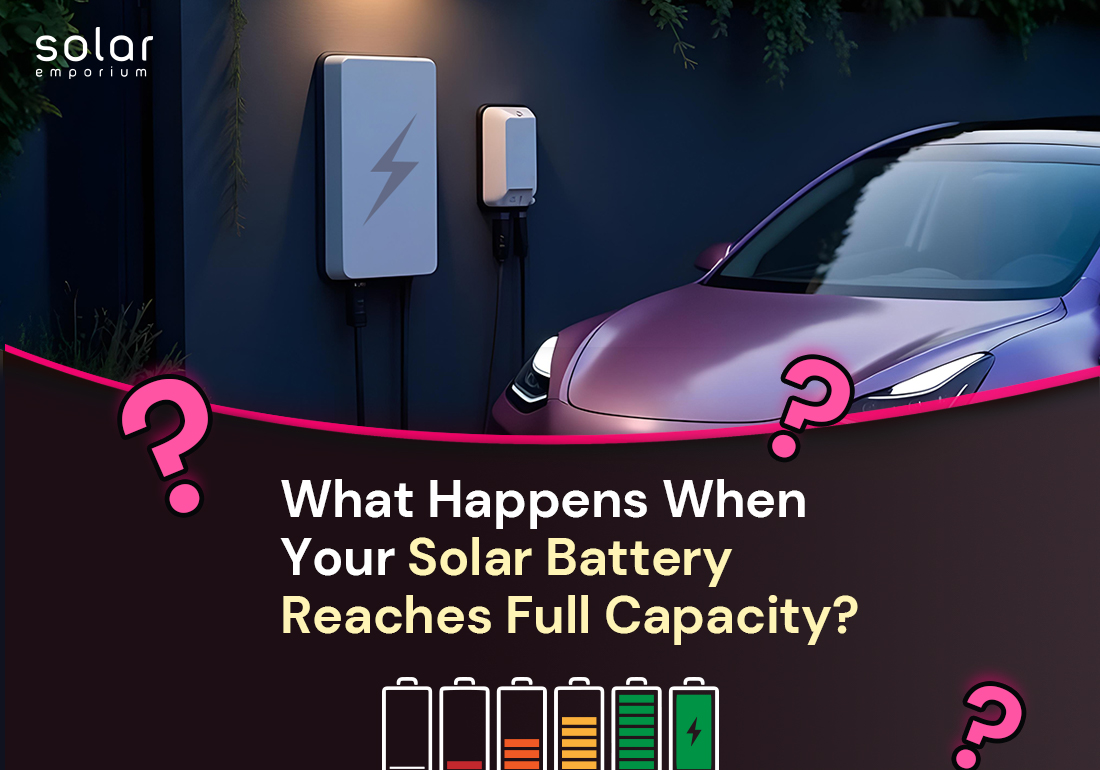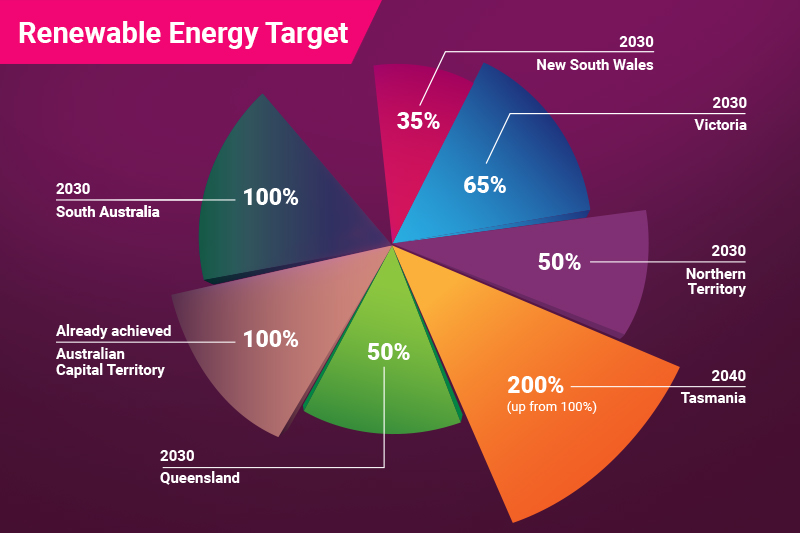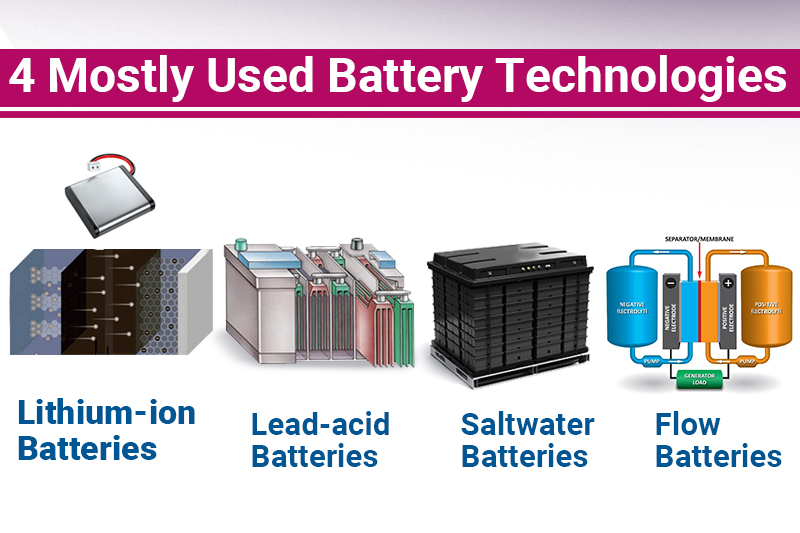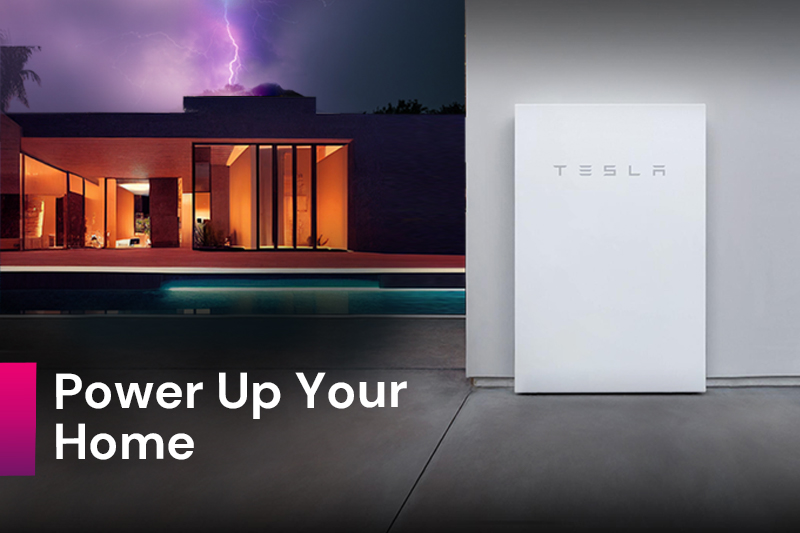When Australia is basking in its vast, abundant, sun-soaked landscapes and scorching summers, it’s the perfect time to take control of your energy needs.
The country’s residents have an incredible opportunity to harness the sun’s boundless energy to power their homes and businesses. But what happens when the sun goes down or the clouds roll in?
Well, there is a transformative solution we all know: Solar Batteries.
Whether day or night, summer or winter, solar batteries power your home with uninterrupted service while reducing your dependency on fossil fuel. You don’t have to rely on fluctuating electricity prices or stress about power outages.
However, with various available options, choosing and installing the best solar battery can be daunting.
Are you too struggling to pick the best battery in Australia?
Don’t stress about it! This blog will walk you through the process, from understanding the different types of batteries to finding a qualified installer.
So, without any further ado, let’s explore Solar Emporium’s detailed guide to choosing and installing the right solar battery.
A Deep Dive into the Environmental Impact of Solar Batteries!
The working principle of solar batteries is pretty straightforward. It stores the excess energy your solar panel produces during peak sunlight hours.
You can use this electricity during high demand or cloudy days when your panel can’t generate enough power. With batteries, you can rely less on grid electricity, reducing your carbon footprint and energy cost while increasing energy independence.
So, what are the best types of solar batteries?
In general, among different battery chemistries, solar batteries typically come in two main types:
- Lithium-Ion Batteries:
In modern times, lithium-ion batteries are most commonly used in Australia due to their high energy density (90-95%). They can store a large amount of energy in a small space.
Their lightweight, sleek design and longer lifespan make them the preferred choice for modern applications such as solar energy storage, electric vehicles, and other portable devices.
- Lead-Acid Batteries:
Lead-acid batteries are a traditional option that has dominated the battery industry for decades. They are popular because of their reliability and affordability
However, compared to lithium-ion batteries, these batteries are bulkier, have a shorter lifespan, and are less efficient.
Is Solar Battery a Smart Investment for Australians?
Installing a solar battery can be a significant investment for many, but once you consider the savings on electricity bills, you won’t regret it.
Many people often ask: is investing in solar batteries economically viable? What’s the total upfront cost of the battery?
Well, the true cost of battery installation varies from home to home. It depends on the battery’s size, capacity, solar panel efficiency, and the system’s complexity.
On average, the entire solar battery system, including installation, will cost between $5,000 and $15,000.
In Australia, some providers also offer financing options, battery rebates, and incentives to reduce upfront costs and make them widely accessible.
Australia’s solar market is booming rapidly. With more than 3.5 million solar installations across the country, Australia is leading the way in the renewable energy sector.
However, while solar panels are great at generating electricity, many low-income households without battery storage still rely on the grid for power, especially in the evenings when solar production is low.
This reliance on the grid can lead to higher electricity costs and less energy independence.
So, here are some of the top reasons why Australians should consider installing a solar battery:
Batteries Maximize Solar Panel Efficiency
Greater Energy Independence: Power Your Home Day and Night!
By storing energy, you can become less reliant on the grid, which is especially beneficial during power outages or when electricity prices spike.
In addition to urban life, solar batteries also allow power in remote and off-grid areas with limited access to the utility grid.
Want to Reduce Electricity Bills & Carbon Footprints? | Install Solar Batteries
Increase Your Home Value & Make Your Home Aesthetically Pleasing
As people become more environmentally conscious, they mainly focus on maintaining a sustainable lifestyle with energy-efficient smart homes.
Therefore, homes with solar panels and storage solutions like batteries are becoming more attractive to new buyers and gaining significant traction in Australian landscapes in 2025.
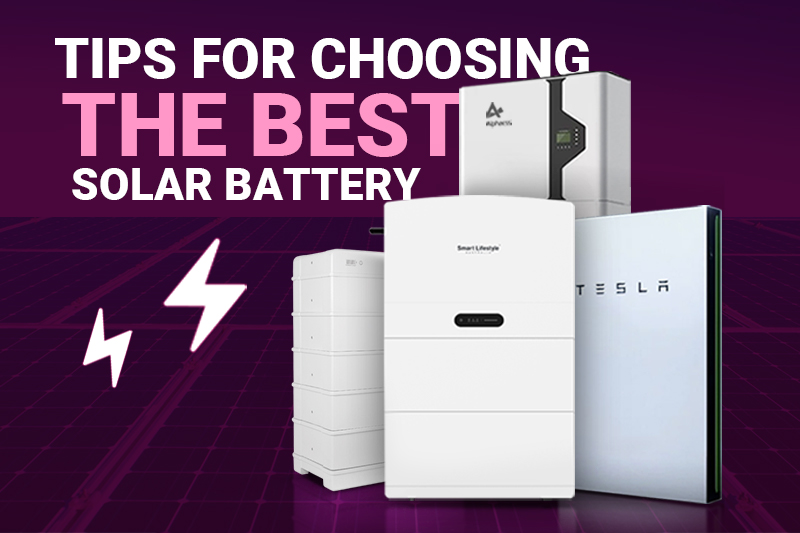
Top 6 Tips for Choosing the Best Solar Battery for Your Aussie Homes
Nowadays, picking up the best solar battery feels like finding a needle in a haystack. With so many options flooding the market, the pressure to pick the right one is real.
Choosing the right solar battery ensures the best return on your investment and maximizes energy savings. But how do you choose the right solar battery for your home?
So, let’s dive into and know 6 key factors to consider while selecting solar batteries:
1. Battery Capacity and Sizing
Battery capacity determines how much energy one solar battery can hold. This ultimately means the more kWh the battery capacity is, the more electricity you can store for later use.
In Australia, most households will need a battery capacity between 5kWh and 15kWh, depending on their energy consumption.
A typical Australian home uses between 15kWh and 20kWh per day, so a 10kWh solar battery could be a good fit for most homes. Therefore, before purchasing, don’t forget to calculate your home’s energy needs for better efficiency.
2. Storage Efficiency
Solar batteries come with different levels of efficiency depending on their chemistry and manufacturing technology. Battery efficiency tells us how much of the stored energy can be used.
For example, more efficient lithium-ion batteries like Tesla Powerwall can deliver more usable energy than traditional batteries, reducing the amount of wasted power.
So, try to look for a solar battery with an efficiency of 90% or higher.
3. Warranty and Lifespan
On average lifespan, a solar battery lasts for 5 to 15 years, depending on the technology. Lithium-ion batteries generally last longer, with some offering up to 10 years of warranty. Therefore, check the warranty terms carefully before making the purchase.
Remember! A longer warranty gives you more peace of mind that your investment is protected.
4. Cost of Solar Batteries
Many people find the high upfront cost of solar batteries challenging. So, if you’re halting between two points on whether to buy, let us assure you—the cost has steadily dropped in recent years, making them more affordable for average Australian homeowners.
The government also offers various rebates and incentives or financial aid that significantly reduce battery installation costs.
5. Depth of Discharge (DoD)
Depth of Discharge (DoD) is crucial to know how much of the battery’s capacity can be used without damaging it.
A higher DoD allows you to use more of the battery’s stored energy, which is why most modern lithium-ion batteries have higher DoD features ranging around 80-90%.
6. Brand Reputation and Reliability
Several reputable battery brands, including Tesla Powerwall, LG Chem, Alpha ESS, Sonnen, and Sungrow, offer battery solutions in the Australian market.
Do proper research and choose a well-known, trusted supplier and accredited solar installers to ensure the product is reliable and backed by excellent customer service.
List of the Best Solar Battery Brands in Australia| Save Energy and Maximize Efficiency!
So, after knowing all the details, what is the best battery for a solar backup?
Here are some of the leading most popular solar battery options in Australia:
Tesla Powerwall
Tesla’s Powerwall is one of the most well-known and widely used solar batteries. It offers excellent performance, a sleek design, and a solid warranty, making it an attractive choice for homeowners.
- Capacity: 13.5kWh
- Efficiency: 90%
- Warranty: 10 years
LG Chem RESU 10H
The LG Chem RESU offers great efficiency and a long lifespan. Its compact and reliable feature makes it perfect for those who need a slightly smaller capacity without sacrificing performance.
The LG Chem RESU10H is for daily cycle use that recharge with electricity generated from PV solar panels or utility grids.
- Capacity: 9.8kWh
- Efficiency: 95%
- Warranty: 10 years
SonnenBatterie Eco
The SonnenBatterie Eco is popular for its advanced software features and integration with smart home technology. It’s an excellent option for energy-conscious homeowners who want more control over their energy usage.
- Capacity: 5kWh – 15kWh
- Efficiency: 90%
- Warranty: 10 years
Alpha ESS Smile 5
Alpha ESS Smile 5 is a flexible solar battery system offering a wide range of capacities. For high efficiency and a solid warranty, this battery can be an ideal option if you are looking for a reliable and scalable solar battery solution.
Also, the system is compact sleek and can be easily integrated with your existing solar setups.
- Capacity: 5kWh – 15kWh
- Efficiency: 95%
- Warranty: 10 years
SLA Life Energy Storage System
SLA ESS is an advanced, all-in-one solar battery storage solution that incorporates AC coupling and offers flexibility for various applications.
It’s built to perform efficiently both outdoors and indoors, ensuring reliable operation in any environment. This battery’s competitive price makes it an excellent entry-level option for those seeking an affordable energy storage system.
- Capacity: 5kWh – 30kWh
- Efficiency: 97.6%
- Warranty: 10 years
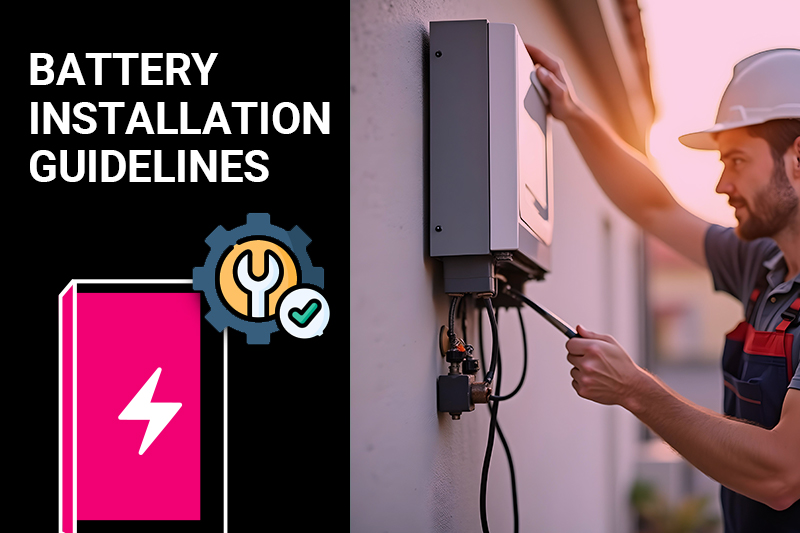
From Planning to Power: Step-by-Step Solar Battery Installation Guidelines
If you’re looking to enhance your solar power setup, installing a solar battery is an important next step to consider. Why? Integrating a solar battery can be a great way to make your home more energy-efficient and sustainable.
Here are some solar battery installation steps to follow:
- Assess your site with a qualified solar installer and determine the best location to install your battery.
- Check the battery’s compatibility before installing and connecting to your solar system. Depending on the complexity of your system, this may take a few hours to a day.
- After installation, your system will be tested to ensure everything works correctly. Your installer will walk you through how to monitor and manage your system.
- While solar batteries are generally low maintenance, they should be checked periodically to ensure optimal performance. You can follow the battery maintenance tips to maximize lifespan.
Types of Battery Installation: Reliable Backup When You Need It!
Grid-Tied Solar Battery System:
This type of battery provides backup power in case of a grid outage. It simply helps to manage your energy usage more efficiently by harnessing daylight for nighttime power.
Grid-Connected Battery with Backup:
This system works similarly to a basic grid-connected battery but with the added benefit of providing backup power during a grid outage with an inverter circuit or through an external gateway.
- Backup via Inverter Circuit
In the event of a power outage, the inverter’s backup circuit kicks in, powering selected appliances in your home.
The inverter’s backup capacity limits the amount of power available, so if the inverter fails, everything on the backup circuit loses power.
- Backup via External Gateway
When the grid goes down, an external gateway disconnects your home from the grid.
The battery then takes over, providing power to your home until the grid is restored. This allows a seamless transition from grid power to battery power.
Off-Grid system:
People often ask: Can solar batteries make off-grid living more viable?
Well, these custom-designed systems are produced especially for remote areas where grid power is unavailable. It works like a power bank that ensures your home remains powered even on cloudy days or stormy nights.
However, an off-grid system may encounter challenges related to weather and seasonal changes, particularly during extended periods of rain. These conditions can significantly affect the system’s performance, requiring multiple batteries for consistent power supplies.
Moreover, the need for an adequate backup system can result in significant costs and maintenance, making it more complex.
Solar Battery Rebates & Incentives in Australia 2025: Save Big on Energy Bills!
Australia offers several empowering home programs and renewable energy targets, which can significantly reduce the cost of solar energy.
The main incentive is the Small-scale Renewable Energy Scheme (SRES), which provides rebates for both solar panels and batteries.
It’s also worth checking with your state or territory government for additional incentives, as local programs may be available to further reduce costs.
Make the Switch to Solar Emporium: Your Smart Choice for Energy Efficiency

Undoubtedly, with the continuous falling price of solar batteries and high energy prices, installing a solar battery is becoming an increasingly attractive option for Australian homeowners.
Not only will it reduce your reliance on the grid, but it can also save you money on your electricity bills in the long term.
By choosing the right solar battery for your home and installing it professionally, you can increase your energy independence and contribute to a more sustainable future.
Trust us, your home deserves nothing less than the best. With the right information and research, solar batteries are a smart investment that pays off both financially and environmentally.
Are you ready to take the next step towards a greener, more cost-effective home?
Contact Solar Emporium today! With more than 48,467 happy customers in New South Wales and Victoria, we value quality over quantity.














